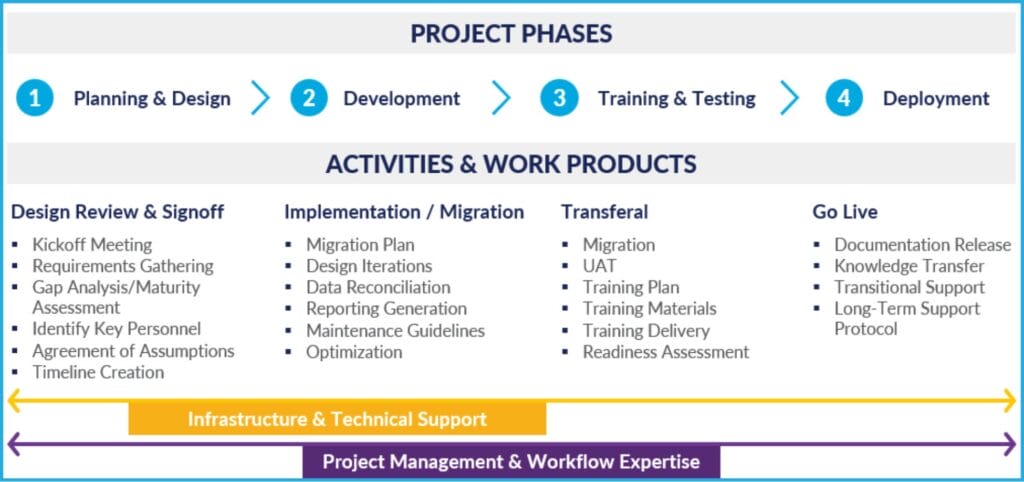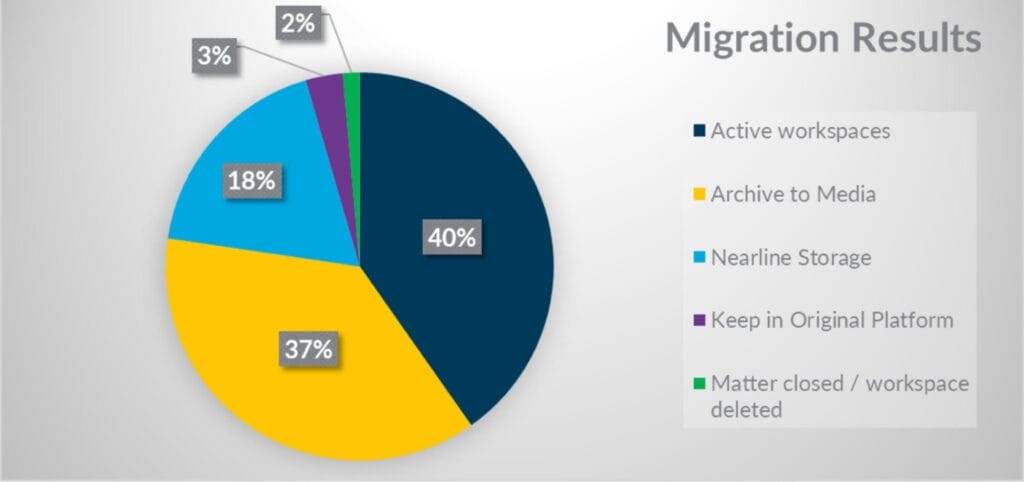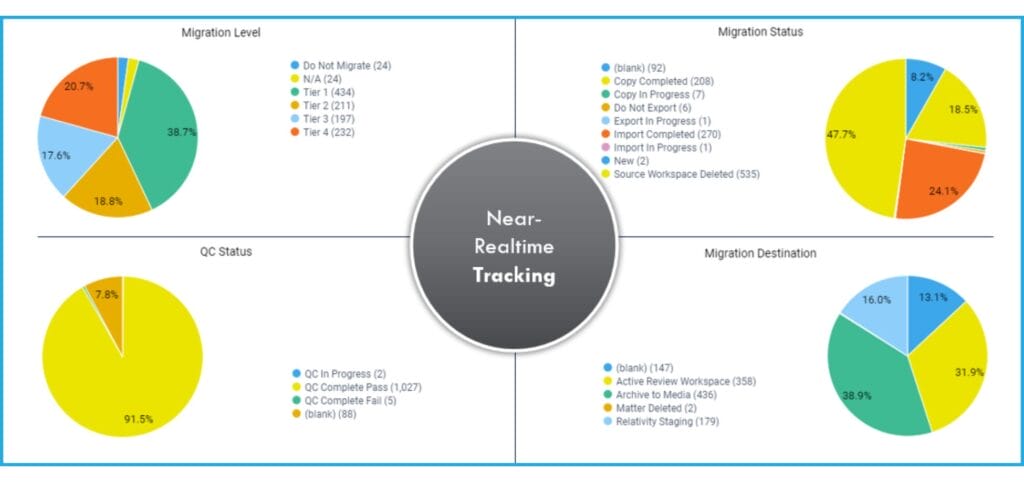There’s a common misconception that data migration is simply the same as a data transfer. However, data migration is much more complicated than data transfer because it involves not just transferring data, but also comprehensive data preparation, validation, technological compatibility, workflow mapping, metrics, and reporting to meet legal discovery, business, and technical requirements.
E-Discovery data migrations are almost never straightforward. Migrating data, whether from legacy systems or from other providers, can be fraught with complications. CDS’s Advisory Services team encompasses migration architects and consultants that have designed, developed, and implemented hundreds of data migrations totaling petabytes of data across multiple eDiscovery platforms.
The Challenges of Legacy Systems and Large Datasets
The major challenges of migrating large datasets from legacy systems include:
- Data quality issues such as duplicates or missing values
- Data loss or corruption during the transfer process
- Complex data mapping to restructure data from the legacy system to fit the new one
- Potential security breaches connected to the vulnerabilities of outdated systems
- Compatibility issues between old and new systems
- Lengthy downtimes during migration that may disrupt discovery deadlines or daily operations
- Thorough testing and validation to ensure data integrity
All these obstacles must be overcome while handling change management and potential employee resistance to changing from the legacy system and the possibility of cost overruns due to unforeseen complications during the process.
CDS’s Four-Phased Data Migration Approach
CDS’s comprehensive four-phased approach helps ensure your migrations are seamless, efficient, and stress-free. Here’s a breakdown:

PHASE 1: Planning and Design
This Phase requires study and analysis culminating in the full migration plan and will lead to system development activities. The project work is broken down into specific tasks and sub-tasks, including the identification of project deliverables and assignment of allocated resources to each task. In the planning & design phase, sufficient requirements details are required to support the development of the project’s migration plan and permit outside validation of this deliverable by all stakeholders. The results of this phase are captured in the migration plan, the primary managerial document in the life cycle of every migration project.
PHASE 2: Development
During the development phase, we take the detailed logical information documented in the previous phase and transform it into machine-executable form and ensure that all the individual parts of the application function properly and interface with other components within the destination platform. During the development phase, project risks and mitigations are defined and discussed with all stakeholders. Data migration and training plans are discussed and user procedures are baselined.
PHASE 3: Testing and Training
The actual benefits from the project begin to materialize during the testing & training phase. Preparations for this stage begin already at the planning and design phase to ensure that all parties have a common understanding of the solution, its readiness, quality, and organizational impact.
PHASE 4: Deployment
The deployment phase includes final migration of all hosted data designated to go into the new hosting platform. During this phase, the new environment will go live with all templates configured and available for use. CDS will complete knowledge transfer, prepare a change management plan, and provide transitional support. Our team also provides post-migration support—ongoing assistance to help your team maximize the benefits of your new environment.
Case Study: Transforming a Large Law Firm’s eDiscovery Workflows
One of the nation’s largest law firms, with nearly 1,000 litigation attorneys and offices coast to coast, has their own in-house eDiscovery/litigation support team that ingests, processes and produces their own data and builds their own analytics indexes with full administrative access to an on-prem Relativity instance.
The Challenge:
The firm was looking to improve speeds, boost efficiency, and eliminate bottlenecks when handling large volumes of data and thousands of active matters.
The CDS Solution:
CDS leveraged their team of consultants and project managers to examine approximately 1,200 workspaces in the law firm’s current on-premises-hosted Relativity environment. After thorough assessment of workspaces and discussions with the law firm’s in-house eDiscovery team, CDS reduced their active hosted cases by 59.7% and successfully migrated the remaining 40.3% active workspaces to RelativityOne. This was done by building out new workspace templates, revising the firms two-factor authentication methods, and making workflow revisions. CDS’s migration led to a massive reduction to the active hosted matters, significantly reducing overall hosting costs:

The Results
Upon completion of the migration, CDS helped lower the firm’s hosting costs by over 50 percent. The migration to RelativityOne allowed the law firm to process larger volumes of data significantly faster, experience much quicker document to document review speeds, and leverage all of the benefits of the RelativityOne environment.
As part of the migration process, CDS leveraged the Relativity Migration Tracker application to track the migration. The Relativity Migration Tracker provides full transparency, giving our clients access to the information that matters most to them. For this particular migration, CDS tracked the status of the migration in near real-time including, but not limited to, migration status, migration destination, QC status, approval for go live, etc. Here is an example of the tracking dashboard:

Microsoft Teams was used to track tasks, implementation defects, workflow gaps, and storage of documented processes and workflows to ensure consistency and accountability across the entire CDS team. Weekly meetings, reporting, and customized workflows / user guides were developed and included as part of the migration and implementation.
Key Takeaways for Organizations Considering Data Migration
Is your firm contemplating a large-scale data migration? Here are some consideration to make:
- A strategic migration approach leads to long-term operational benefits. Careful planning and customization are vital to ensuring a successful eDiscovery data migration. The plan should include pinpointing the origin and location of the data, identifying data volume, format, and size, defining the scope of the data to be migrated, determining a system’s capacity to handle the migration process, and allocating a budget that will allow for smooth migration.
- The importance of optimizing workflows alongside data transfers. Leveraging tools to automate as much of the data migration process as possible is critical. Automated archiving allows companies to retain and access archived data, avoiding the high cost of maintaining the original infrastructure. From a single, secure, centrally managed repository, multiple types of unstructured information are stored, indexed, preserved, expired, and reviewed for eDiscovery.
- CDS can help organizations modernize their eDiscovery infrastructure. CDS’s services cover the complete eDiscovery process, ensuring that you are supported each step of the way from forensic data collection through to production. We function as an extension of your team and provide expertise and technology to help you conquer the biggest discovery challenges. We’re constantly advancing the practice of eDiscovery and advising clients on technology and process advancements that can save time and money.
CDS Advisory Services brings together leading advisors and technical experts to assist clients throughout the discovery process, including with data migration. CDS migration experts support clients in upgrading their existing platforms to access the full power of cloud-first legal technology or alternative on-prem technology. Our deep migration expertise is key to smooth, successful data migrations, from pure transfer and intake to data and workflow optimization as it enters new systems.
To find out more about how CDS can streamline your organization’s data migration journey, contact us at and schedule a consultation today.



